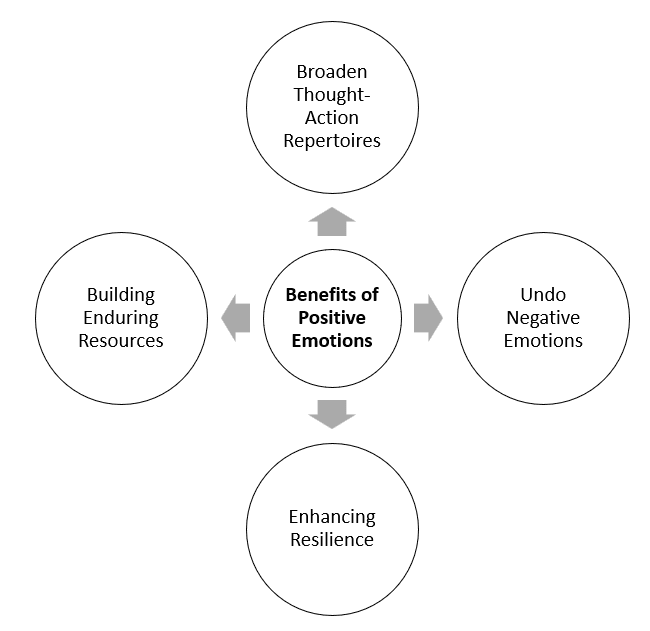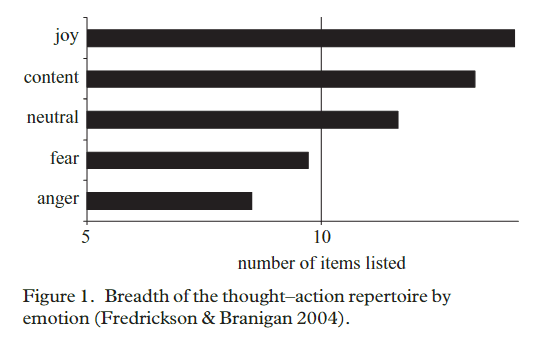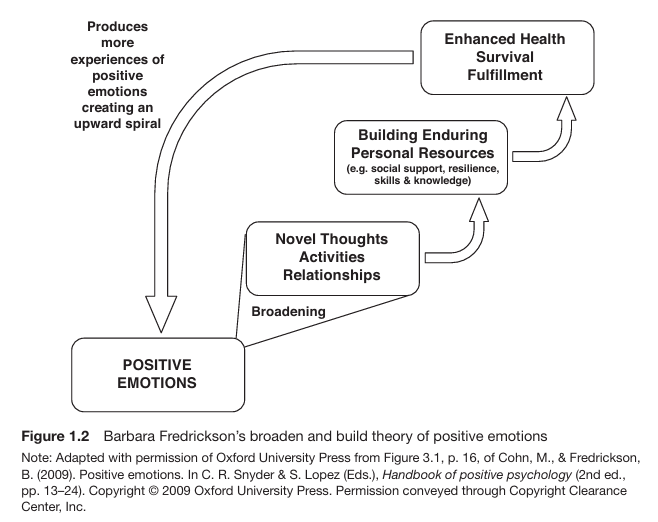Positive Emotions
Broaden and Build theory is one of the most popular theories of positive emotions. Positive emotions are a subset of emotional experiences that enhance our psychological and physical well-being. They are characterized by feelings of cheerfulness, joy, contentment, and happiness. Unlike negative emotions, which are often associated with distress and discomfort, positive emotions contribute to a more fulfilling and enriched life experience.
Seligman (2002) classifies positive emotions into three categories–
- Those associated with the past
- Those associated with the present
- Those associated with the future.
Positive emotions associated with the future include optimism, hope, confidence, faith and trust. Similarly, the main positive emotions associated with the past are Satisfaction, contentment, fulfilment, pride and serenity.
Whereas, there are two distinct classes of positive emotions concerned with the present– momentary pleasures and more enduring gratifications.
Professor Barbara Fredrickson (2002) at the University of Michigan has extended the idea that positive emotions lead to non-zero-sum games. She developed the broaden- and-build theory of positive emotions to explain how positive affective experiences not only signal personal well-being but also contribute to personal growth and development.
Read More- Positive Emotions
BROADEN AND BUILD THEORY
Positive emotions do more than make us feel good temporarily; they broaden our cognitive and behavioral capacities, allowing us to think and act in more flexible, creative, and exploratory ways. Over time, this leads to the development of valuable physical, psychological, and social resources that contribute to long-term well-being and resilience.
Fredrickson’s theory was groundbreaking in positive psychology because it was one of the first frameworks to explain why positive emotions matter beyond temporary pleasure. It offered a contrast to the evolutionary focus on negative emotions, like fear or anger, which were previously seen as central to survival.
She makes two important distinctions-
- Distinction Between Mood and Emotion- mood is a general, long-lasting state of emotional experience, such as feeling happy or sad over the course of days or weeks. It reflects an overall emotional tone but lacks specific triggers.Whereas emotion is a temporary, intense reaction to a particular event or stimulus, such as joy after achieving something or anger after being hurt. Emotions are more discrete and fleeting than moods.
- Positive Emotions vs. Sensory Pleasures- positive emotions result from cognitive appraisals and meaningful life events, such as pride from an accomplishment or joy from spending time with loved ones. These emotions are important for psychological growth and are not just about feeling good in the moment. Whereas sensory pleasures are automatic, physiological responses to fulfilling basic needs (e.g., eating, resting). While these experiences bring temporary satisfaction, they are not the focus of Fredrickson’s theory because they don’t lead to long-term growth or resource building.
Effects of Positive and Negative Emotions
1. Negative Emotions- Narrowing Thought-Action Repertoires- Negative emotions (fear, anger, disgust) are evolutionarily designed to help us respond to immediate threats by narrowing our focus and driving specific action tendencies.
Fear → Flight or escape.
Anger → Attack or confront.
These responses restrict our attention to immediate survival-related tasks, focusing on the threat and reducing the range of possible actions.

Framework of the Theory (Van Wyk, 2016)
2. Positive Emotions- Broadening Thought-Action Repertoires- In contrast, positive emotions broaden our thinking, making us more open to exploring new ideas, trying different actions, and being creative. This broadening enhances cognitive flexibility, problem-solving, and innovation.
Joy → Encourages play, exploration, and creativity.
Interest → Fosters curiosity and learning.
Love → Deepens social bonds and nurtures supportive relationships.
Fredrickson’s research shows that when people experience positive emotions, they see more possibilities in any given situation. Their mindset becomes more inclusive and expansive, which supports growth and resilience.
Four Key Benefits of Positive Emotions in the Broaden-and-Build Theory

4 Benefits of Positive Emotions
1. Broaden Thought-Action Repertoires- Positive emotions expand the number of potential actions and ideas that come to mind, making it easier to think creatively and explore new solutions. In a study by Fredrickson, participants who watched clips inducing joy or contentment reported a greater number of things they wanted to do compared to those who watched fear or anger-inducing clips. Positive emotions made them more open to multiple possibilities, while negative emotions restricted their range of thoughts and actions.

Broadening of Thought-Action Repertoire
2. Undo Negative Emotions- Positive emotions have a unique ability to counteract or “undo” the physiological and psychological effects of negative emotions. While negative emotions narrow focus, positive emotions restore a more balanced state, reducing stress and tension. In an experiment, participants who were stressed by preparing for a speech recovered more quickly (lower heart rate and blood pressure) after watching joyful or contentment-inducing films, compared to those who watched neutral or sad films. Positive emotions helped “undo” the cardiovascular stress caused by anxiety.
3. Enhancing Resilience- Resilience refers to the ability to recover from setbacks or stressful experiences. Positive emotions help build resilience by fostering a mindset that is more optimistic and proactive. Fredrickson’s team measured resilience in students and found that those with higher resilience experienced more positive emotions during stressful situations, such as preparing a speech. These students recovered from stress more quickly, showing that positive emotions help buffer the effects of negative experiences.
4. Building Enduring Resources- Positive emotions contribute to the development of long-lasting personal resources, including-
- Physical Resources- Play and exploration during joyful moments lead to greater physical strength and stamina.
- Psychological Resources- Interest and curiosity during positive moments build intellectual and creative abilities.
- Social Resources- Love and joy foster stronger, more supportive relationships, creating a robust social network.
By broadening our thinking and actions in the short term, positive emotions help us build lasting resources that support long-term well-being.
Upward Spiral of Well-Being
Positive emotions create an “upward spiral”. When we experience positive emotions, we build resources that, in turn, make it easier to experience more positive emotions. This upward spiral leads to greater emotional resilience, stronger social bonds, better health, and an overall higher sense of well-being.

The Upward Spiral Caused by Positive Emotions
Example of a Downward Spiral- Depression can trigger a cycle of negative emotions, pessimistic thinking, and further emotional deterioration. In contrast, the broaden-and-build theory posits that positive emotions can reverse this process, leading to a cycle of enhanced well-being.
Over time, this upward spiral strengthens our physical, psychological, and social capacities, allowing us to cope better with challenges and enjoy greater life satisfaction.
Strengths of the Broaden-and-Build Theory
The key strengths of the theory include-
- Innovative Perspective on Positive Emotions- Fredrickson’s theory emphasizes the adaptive functions of positive emotions, a shift from the traditional focus on negative emotions related to survival and threat management. This perspective encourages a more holistic understanding of emotional experiences.
- Empirical Support- A substantial body of research has provided empirical support for the theory. Studies have demonstrated how positive emotions broaden cognitive flexibility, promote creative thinking, and enhance social connections. These findings validate Fredrickson’s claims and highlight the importance of positive emotions in enhancing well-being.
- Focus on Resource Building- The theory posits that positive emotions build enduring resources—physical, psychological, and social—which can help individuals cope with stress and adversity over time. This resource-oriented approach encourages individuals to cultivate positive emotional experiences as a means of enhancing resilience.
- Upward Spiral Model- The concept of an upward spiral of well-being, where positive emotions lead to increased resilience and further positive experiences, is an attractive and hopeful proposition. It suggests that small changes in emotional experiences can lead to significant improvements in overall life satisfaction.
- Interdisciplinary Impact- The broaden-and-build theory has implications beyond psychology, influencing fields such as education, health, and organizational behavior. Its application in various domains highlights the theory’s relevance and adaptability.
Weaknesses of the Broaden-and-Build Theory
The key weaknesses of the theory include-
- Overemphasis on Positive Emotions- Critics argue that the theory may overemphasize the importance of positive emotions while downplaying the potential benefits of negative emotions. Negative emotions can motivate change, prompt critical thinking, and facilitate problem-solving in ways that positive emotions may not.
- Limited Understanding of Emotion Interactions- The theory does not fully address how positive and negative emotions interact and coexist in complex emotional experiences. Life is not solely positive or negative; rather, individuals often navigate a spectrum of emotions. Understanding these interactions may provide a more nuanced view of emotional experiences.
- Variability in Individual Responses- Individual differences (such as personality traits, cultural background, and situational context) can influence how people experience and respond to positive emotions. The theory may not account for these differences sufficiently, leading to potential oversimplifications.
- Lack of Clear Mechanisms- While the theory outlines the broad effects of positive emotions, it provides limited insight into the specific mechanisms that underlie the process of broadening and building. Further research is needed to clarify how positive emotions translate into tangible resources and outcomes.
- Potential for Misapplication- The idea that positive emotions can always lead to beneficial outcomes may encourage individuals to suppress or avoid negative emotions, leading to emotional invalidation or difficulties in processing legitimate emotional responses. This could be detrimental to mental health in the long term.
- Cultural Considerations- The theory is primarily based on Western notions of well-being and emotional expression. Critics argue that it may not adequately consider how cultural factors influence the experience and expression of positive emotions. Different cultures have varied approaches to emotions, which can affect the applicability of the theory across diverse populations.
Conclusion
Positive emotions are vital for enhancing individual well-being and resilience. Barbara Fredrickson’s Broaden-and-Build Theory highlights how these emotions broaden our thinking, promote creativity, and strengthen social connections, contributing to an upward spiral of emotional health. While positive emotions uplift our spirits and help us build essential resources, it’s important to recognize the valuable roles of negative emotions as well, which can prompt growth and reflection.
In summary, cultivating positive emotions enriches our lives and fosters meaningful relationships, while a balanced emotional landscape allows us to navigate life’s challenges effectively. Embracing the full spectrum of emotions empowers us to achieve greater well-being and fulfillment.
Reference
Van Wyk, R. (2016). An evaluation of the Positive Emotional Experiences Scale: A preliminary analysis. SA Journal of Industrial Psychology, 42(1), 1-12.
Fredrickson B. L. (2004). The broaden-and-build theory of positive emotions. Philosophical transactions of the Royal Society of London. Series B, Biological sciences, 359(1449), 1367–1378. https://doi.org/10.1098/rstb.2004.1512
Baumgardner, S. R., & Crothers, M. K. (2009). Positive psychology. Pearson Prentice Hall.
Carr, A. (2011). Positive psychology: The science of happiness and human strengths (2nd ed.). Routledge.
Subscribe to Careershodh
Get the latest updates and insights.
Join 15,187 other subscribers!
Niwlikar, B. A. (2022, April 13). The Broaden and Build Theory- 4 Important Benefits of Positive Emotions. Careershodh. https://www.careershodh.com/the-broaden-and-build-theory/
